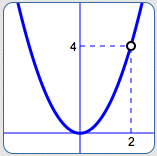 Introduction to Puncture Points (Holes)
Introduction to Puncture Points (Holes)
Rational functions can exhibit puncture points (also called ‘holes’).
As you'll learn in Calculus, puncture points are an example of a ‘removable discontinuity’.

Here's the idea.
The function $\,\displaystyle R(x) := \frac{x^3-2x^2}{x-2}\,$ certainly looks like a typical rational function.
Upon closer inspection, though, we see that there's an extra factor of $\,1\,$ in the formula:
$$ \begin{align} \cssId{s6}{\frac{x^3 - 2x^2}{x - 2}}\ &\cssId{s7}{=\ \frac{x^2(x-2)}{x-2}}\cr\cr &\cssId{s8}{=\ x^2\cdot\frac{x-2}{x-2}} \end{align} $$Therefore, $\,\displaystyle R(x) = \frac{x^3-2x^2}{x-2}\,$ has exactly the same outputs as the much simpler function, $\,P(x) := x^2\,,$ except that the function $\,R\,$ isn't defined when $\,x = 2\,.$
The graphs of both $\,P\,$ and $\,R\,$ are shown below—the puncture point (hole) in $\,R\,$ is caused by that extra factor of $\,1\,.$


Puncture points are studied in more detail in a future section.